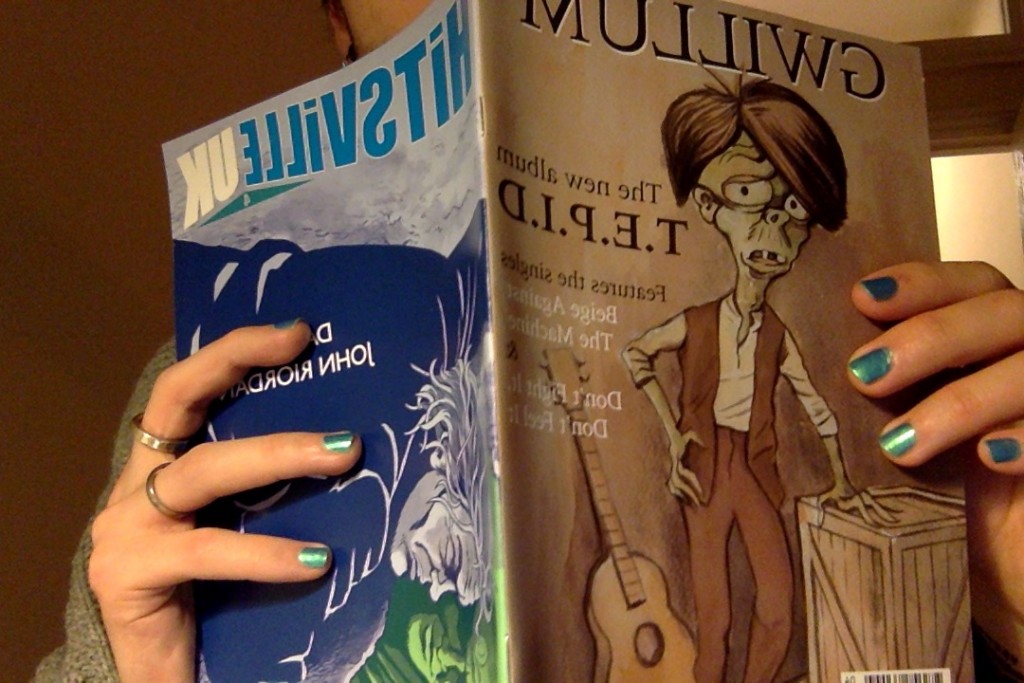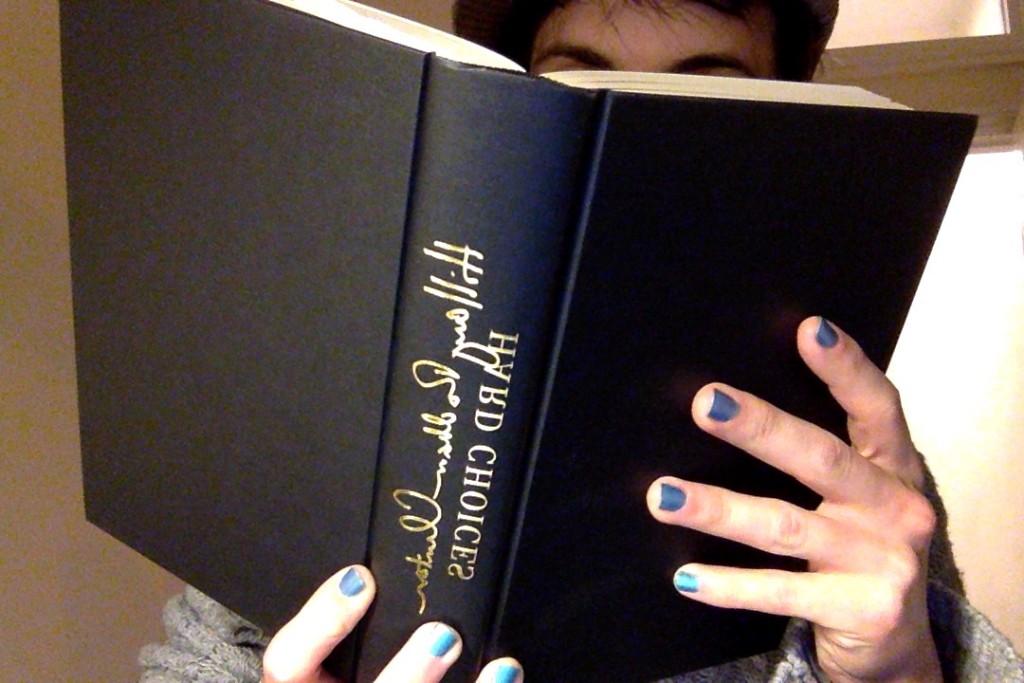Yer man Michael Phoenix (@mphoenixuk) asks a question about binding options. It’s a good question. I like it. I’m gonna talk about it.
For the purposes of commercial comic printing there are three main types of binding. They are, in order of the order I wrote them down in:
- Saddle Stitched

Hitsville UK, by John Riordan and Dan Cox (who doesn’t appear to have a twitter, which I am suspicious of.) - Perfect Bound

The Waterbringer, by MD Penman - Hardback

Hard Choices, by Hillary Rodham Clinton
Look, full disclaimer: I only printed two out of these three examples.
There’s a bit of a breakdown within classes, but these are the headliners. So what about them?
Saddle Stitched
Stitching is the most basic binding going. It’s staples. We call it stitching because we like to confuse you. We also call the staples themselves “wires”. We’re a fun bunch, printers are.
Good for:
- Page counts up to about 48pp inc cover.
- One shots or ongoing series.
- Keeping costs down.
- Self cover comics.
Drawbacks:
- Page counts have to be divisible by exactly 4 (although this is best practice for all bindings, really).
- Struggles to lie flat right out of the box.
- Puts a (pretty low) ceiling on what you can acceptably charge for your comics.
Perfect Binding
Additional full disclaimer: perfect binding (or, more specifically, PUR binding) is my favourite kind of binding, and I have no intention of attempting to be unbiased.
Good for:
- Page counts of 48pp and up (although we can in some circumstances PUR bind a block of as few as 24pp).
- Collecting an entire story or arc. Giving the customer a sense of “one and done” rather than having to consider how long it’ll take for the next chapter to appear.
- Looking really cool like a book you’d buy in a shop. (I did mention the bias.)
- Lifts the ceiling you can put on your pricing. It’s more expensive than stitching, but not by a ridiculous amount. Given that you can charge 50-100% more for a perfect bound book than its stitched equivalent it’s always worth considering.
Drawbacks:
- Spine clearance requirements do have a bit of an impact on your layout. Not huge, but it’s another factor to bear in mind.
- Heavy. Much, much heavier. You might not care right now, but you will when a) you’re dragging them to a con or b) you’re posting them.
- More pages = more work for you getting everything ready.
- Usually requires a laminate on the cover, which is another small additional cost. It looks nice, and it protects your covers (especially your spine) from damage in transit, but it’s a small additional cost.
PUR vs EVA
Oooh, yeah. You need to know about that. Here at CPUK (I’m trying to make the acronym a thing – have you noticed over the last few posts?) we almost exclusively use PUR binding. The major difference is the type of glue used: perfect binding uses ethylene vinyl acetate (EVA) and PUR uses polyurethane reactive (PUR) adhesive. There’s a small chance that you’re not a chemist, in which case the difference won’t be immediately clear, so let me explain.
In a standard page pull test (this is as basic as it sounds) PUR binds show up somewhere in the region of 40-60% stronger than traditional perfect binds, even though they use less adhesive for binding. That means that if you have a book that’s intended for multiple readings (perhaps, to pluck a random example from the air, a graphic novel) a PUR binding is far, far less likely to fall apart over time. It’s also far more resistant to spinal cracking when opened out flat for reading/sketching inside.
Another advantage of PUR over traditional perfect binding is that it lies flatter. Since the adhesive is so much stronger we need to use less of it, which means it allows for a more compact spine (this is also why we can bind smaller book blocks).
Traditional perfect binding has some advantages over PUR, so it’s not one to completely discard. It’s a bit cheaper, which is handy. It can also be applied to thinner coated papers, which is why you’ll often see it used on glossy mags in the shops. EVA binding also allows for a looser bind, which means you don’t need so much clearance from the spine. PUR binding is very tight indeed right out of the box, which can make a book feel quite stiff when you’re first looking at it. Of course the flipside of that is durability – it’s all well and good being able to flatten out your books on a table for display at a con, but if it breaks the spine then you’ll get pages falling out as people read. I’m told that people don’t like that.
If you’re perfect binding we’ll generally make the decision between EVA and PUR for you (personally I use the term “perfect binding” pretty much interchangeably). If you have a strong preference for EVA over PUR do mention this, because as I say we’ll usually default to PUR.
Hardback
Hardback books are serious business. The benefits are obvious, so I’ll skip those, because there are some not insignificant drawbacks…
- Setting these up is a pretty complex process. To give you an example, here’s the cover template for Mike Garley’s forthcoming collection of The Kill Screen.
- Hardbacks are phenomenally expensive to produce. The risks are high, because you’re going to need to charge a premium for them. This is very much a thing you’ll want to kickstart, because if you haven’t established demand in advance you’re at a huge risk of being left horribly out of pocket.
- Production times are longer than on other bindings. Not hugely longer, but you want to watch out for that – especially if you’re a regular customer and used to quick turnovers. (Side note, because of the non-comics work done on the side, Christmas is a terrible time of year to order a hardback. The casing machine is pretty much perpetually in use making those daft little photo gift books you see advertised on Facebook and the like. Pays the bills, innit?)
- Because of the complexity of the work, we tend to produce these only in short run batches. There’s a ceiling of about 500, which means you’ll be dealing with a hefty per unit price.All that being said, hardbacks do look really, really cool. And if you’ve established the market beforehand they’re a great addition to your offering for hardcore fans. Just… maybe allow more time than usual in these projects for back and forth on files, unforeseen setbacks and the like…That’ll about wrap us up for today. As ever, if you have any questions drop an email and we’ll do our best to answer them. Thanks again to Michael for suggesting the post.
Originally posted on Comic Printing UK and shared with permission.
- Comic Book Printing: On Bleeds and Clearance - April 11, 2019
- Comic Book Printing Templates - April 4, 2019
- How much does it cost to print a comic? - March 21, 2019

